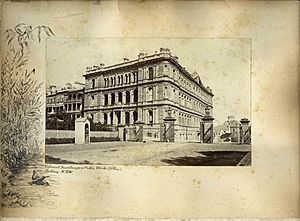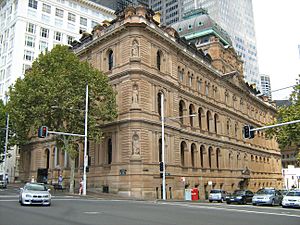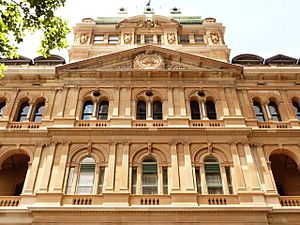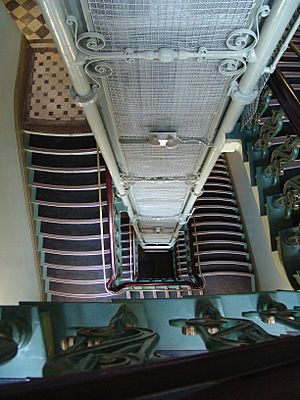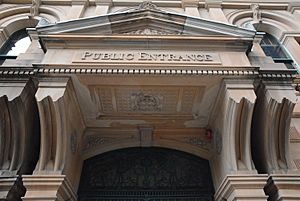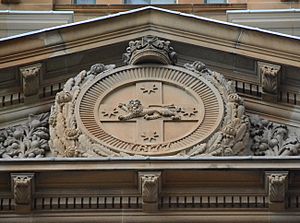Chief Secretary's Building facts for kids
Quick facts for kids Chief Secretary's Building |
|
|---|---|
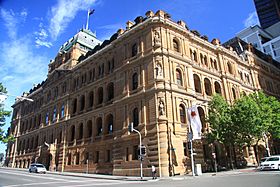
The building as viewed from Bridge Street and Phillip Street
|
|
| Former names | Colonial Secretary's Building |
| General information | |
| Status | Complete |
| Type | Government administration |
| Architectural style |
|
| Address | 121 Macquarie Street, Sydney, New South Wales |
| Country | Australia |
| Coordinates | 33°51′49″S 151°12′44″E / 33.8635°S 151.2123°E |
| Current tenants |
|
| Construction started | 1873 |
| Completed | 1886 |
| Opened | 1881 |
| Cost |
|
| Renovation cost | A$32 million (2005) |
| Client | Colonial Secretary of New South Wales |
| Owner | Government of New South Wales |
| Technical details | |
| Material |
|
| Floor count | 5 |
| Design and construction | |
| Architect |
|
| Architecture firm | Colonial Architect of New South Wales |
| Developer | Government of New South Wales |
| Renovating team | |
| Architect | Government Architect's Office |
| Awards and prizes |
|
| Official name | Chief Secretary's Building; Colonial Secretary's Building |
| Type | State Heritage (built) |
| Criteria | a., c., d., e., f. |
| Designated | 2 April 1999 |
| Reference no. | 766 |
| Type | Other – Government & Administration |
| Category | Government and Administration |
The Chief Secretary's Building is a historic government building in Sydney, Australia. It was originally known as the Colonial Secretary's Building. This beautiful five-storey building is located at 121 Macquarie Street, 65 Bridge Street, and 44–50 Phillip Street in the city center.
It was designed by Colonial Architect James Barnet in the Victorian Free Classical style. The building was constructed in two main parts. The first four levels were finished between 1873 and 1881. Later, between 1894 and 1896, Walter Liberty Vernon added the fifth level and the dome.
Made from sandstone, this building was once the main office for the colonial government. It has been used by the Government of New South Wales ever since. Today, it still houses the office of the Governor of New South Wales. The main group working there now is the Industrial Relations Commission of New South Wales. Some of its large rooms are even used as courtrooms.
History of the Building
In 1856, New South Wales gained "responsible government." This meant the colony could make more of its own decisions. This change created a need for new government offices. Many departments were spread out in different buildings, some rented and some very old.
During the late 1800s, the Colonial Secretary's job was very important. The Premier (the head of the government) often held this role. Because of this important position and the growing need for office space, plans for a new building were made. The chosen location was special. It was near Government House and Parliament House, showing its importance.
Building the Chief Secretary's Office (1860s-1890s)
By 1869, enough money was available to start building. James Barnet, the Colonial Architect, designed a large building for the Chief Secretary's office and the Works Department. Construction began in 1873.
The building took many years to complete and cost more than expected. By 1878, over A£76,000 had been spent, which was A£16,000 more than planned. The final cost for the main building was A£81,558 by 1880. Finishing touches continued into 1881.
Soon after it opened, changes were needed. The departments found they didn't have enough space. By the late 1880s, the building was full. People complained about staff being too spread out. So, they decided to make the building bigger.
In 1889, plans were made for an extension facing Phillip Street. This new part would be six storeys tall. The goal was to build it quickly and cheaply, costing less than A£20,000. Construction started in 1890. While this first extension was being built, approval was given for another extension to it.
Changes from the 1890s to 1990s
The second extension was mainly for the Public Works Department. It would connect to the new building and free up space. This part involved buying and tearing down more houses along Phillip Street. The cost was estimated at A£14,136.
To avoid even more costly extensions, architect Walter Liberty Vernon suggested adding two new floors to the existing building. He was worried this would make the building look unbalanced. This addition included a large mansard roof and a central dome. These changes were finished in 1893, costing A£54,926. The dome was covered in aluminium in 1895–1896, which was very new for the time.
For most of the 1900s, only small changes were made to the building as needed. For example, in the 1920s, a private staircase was added for the Minister for Health. After World War II, the building was updated. In the 1960s, the Public Works Department moved to a new building. This allowed the Chief Secretary's Building to be renovated for new uses.
From the late 1960s to 1971, the building changed a lot to welcome new groups like the Divorce Courts. By the 1980s, people realized how important this building was to Sydney's history. As a special project for Australia's 200th birthday, A$2 million was spent to restore the stonework. This work was completed in 1990.
Building Design
The Chief Secretary's Building has two main parts that are connected. The original part, facing Macquarie, Bridge, and Phillip Streets, is a four-storey sandstone building with a copper and slate roof and a copper-covered dome. The Phillip Street addition is a five-storey sandstone building with copper roofs.
James Barnet designed the original building in the Victorian Free Classical style. This style features strong basement walls, arched windows, wide balconies, and low roofs hidden behind decorative walls. When Walter Liberty Vernon added to the building, he used the Victorian Second Empire style. This style is known for its iron-decorated roofs and dome.
Barnet used different decorations on each floor and even within each floor. The most detailed decorations were in the hallways, entrances, and important rooms. Simpler decorations were used in other areas.
Architecture Details
The building's style has been called "Venetian Renaissance" and Victorian Free Classical. The fifth floor and dome were added in the 1890s by Walter Liberty Vernon. Barnet wasn't happy with these additions because they made the building look less like his inspiration, the 16th-century Palazzo Farnese in Rome.
The building has nine life-size statues: six outside and three inside. These statues represent the different purposes of the building's sections. The entrances on the three streets are clearly marked:
- The main entrance at 121 Macquarie Street is labeled "Colonial Secretary". This part of the building has statues representing Mercy, Justice, and Wisdom outside. Inside, there is a marble statue of Queen Victoria.
- The central entrance at 65 Bridge Street is labeled "Public Entrance". Inside, there is a statue of a female figure representing New South Wales, with a merino sheep at her feet.
- The 44 Phillip Street entrance is labeled "Secretary for Works". Outside, there are statues representing Art, Science, and Labour. Inside, there is a statue of Edward VII when he was the Prince of Wales.
The marble statues inside were made by Giovanni Giuseppe Fontana. The sandstone statues outside were created by Achille Simonetti.
Inside, the building features beautiful Australian Red Cedar wood, fancy tiles, and decorated ceilings. The design of the building largely shows the taste of Sir Henry Parkes, who was the first Colonial Secretary.
The Executive Council Chamber, also known as the Cabinet Room, was where many important meetings took place that led to the Federation of Australia. This room is still very well preserved with old furniture and paintings.
Between 1988 and 2005, the building underwent major restorations. Today, it is open to the public. You can see historical displays and even look through glass lift shafts to see how the building was constructed.
Condition and Changes
The building is in good physical condition. The original building (levels 1 to 4) was built between 1873 and 1881. The fifth level and dome were added in 1894-96.
The Phillip Street additions were built in four main stages from 1890 to 1893. Over the years, other changes included:
- Before 1897: A room was added on levels 2 and 3 of the original building.
- 1914: The Governor's Suite was created on level 2.
- 1942: The Bridge Street lift was changed from hydraulic to electric.
- After 1970: An old toilet block in the courtyard was removed. The building was re-roofed, and the sandstone outside was cleaned.
Why the Building is Important
The Chief Secretary's Building is very important to Australia's history and culture. It shows the importance of the Colonial Secretary's office, which was a powerful government department. Decisions made here affected everyone in the colony.
After 1856, the Premier of New South Wales often held the Chief Secretary's job. This shows how important the role was. Famous politicians like Henry Parkes worked here and pushed for big changes like Federation.
The building's size and grand design show how important the departments inside were. It also shows how government offices worked in the late 1800s. The beautiful interior shows the refined taste of the time. Because it has always been used by the government, changes to the building over time also show how society changed, like more women joining the workforce.
The building is one of Sydney's most important architectural works from the late 1800s. It features the work of two great architects, Barnet and Vernon. It is still a key part of Sydney's historic streetscapes.
Its location near Government House, Parliament House, and other major government offices shows its central role in politics and public administration.
The Chief Secretary's Building was added to the New South Wales State Heritage Register on 2 April 1999.
Historical Significance
The building is important because it shows the history of government in New South Wales. The Chief Secretary's office, which started in 1788, grew to have huge power over the colony.
The fact that Premiers often held this job until the mid-1900s highlights its importance. The Executive Council Chamber inside the building also shows this strong link between political leaders and government administration.
Many famous figures in NSW history, like Henry Parkes, Charles Cowper, and John Robertson, worked in this office. They used their positions to campaign for important issues like Federation and land reforms.
The building's size and grand design show how much the Public Works Department and other government departments grew. It replaced a much smaller building from 1813, showing the increase in government prestige.
Its location is also historically significant. It's in an area that has been central to government life since the very first Government House was built there. It's close to Parliament, the Treasury, and other key offices.
The building's layout and detailed finishes show how the public service worked in the 1800s. It's a rare example of such a large government office from that time. The additions made in the 1890s show the growing needs of the Public Works Department and the expansion of the public service.
The continuous use of the building by the government and the changes made over the 1900s also show how society changed, for example, with more women working in government.
Artistic and Technical Achievements
The Chief Secretary's Building is beautiful and adds a lot to the historic streets of Phillip, Macquarie, and Bridge Streets. It's still a very important building in Sydney's government area.
The artworks and finishes inside, many bought from the 1879 Sydney International Exhibition, are of very high quality. They show the importance of the department and the artistic tastes of the late 1800s.
Architecturally, the building is very well designed, both inside and out. It represents important works by two great 19th-century architects, Barnet and Vernon. Barnet thought it was second only to his work on the GPO. Vernon's additions matched the original quality, even during a time of economic difficulty. The Chief Secretary's Building is one of the most important public buildings from the 1800s, similar to the GPO and Sydney University.
Social Importance
The Chief Secretary's Building is socially important because it was the workplace for departments like Public Works. These departments had a huge impact on people's lives. The building's size and beauty show how important and respected government work was.
The Executive Council Chamber is important because it has been used for key government decisions for a long time.
Research Potential
The building has scientific and technical importance because its dome was covered with corrugated aluminium in 1895-1896. This was one of the earliest uses of this metal for roofing anywhere in the world.
The site might also hold archaeological information about the area's past, including the grounds of the first Government House. The building itself can teach us about how it was used in the past, like the old lift and a flag cupboard.
Restoring the original decorations can also help us understand more about Victorian public buildings.
Unique Features
The Chief Secretary's Building is a rare example of a large, high-quality government office from the 19th century. It has a special collection of items from the 1879 International Exhibition, chosen to reflect the tastes of Sir Henry Parkes. The use of aluminium on the dome in 1895-1896 is believed to be one of the first times this metal was used in such a way globally.
A blue plaque was placed on the building on 6 August 2024. It honors Kathleen M. Butler, who was known as the 'Godmother of Sydney Harbour Bridge', as this was her former workplace.
See also
- Australian non-residential architectural styles
- History of New South Wales
- History of Sydney
- Architecture of Sydney


